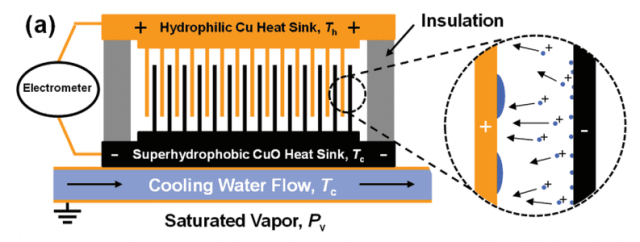Green Energy: Water Droplets Can Generate Power For Our Smartphones
Researchers across the globe are busy finding ways of generating green energy that can be used to charge our electronic devices such as smartphones, tablets and notebooks. In a recent development, a R&D team from MIT has been able to demonstrate how water droplets spontaneously jumping away from superhydrophobic surfaces during condensation, can generate a small amount of electricity that can power our smartphones. The team comprised of Mechanical Engineering Professors -Evelyn Wang, PostDoc Nenad Miljkovic and two others from MIT. Another impressive feature of the setup is that, not only can it generate electricity from the humidity in air, but it also produces clean water in the process.
Created with the use of a series of interleaved flat metal (copper) plates, the setup can actually make use of any conductive metal such as aluminum, which is way cheaper. In their experiment, initially they were able to produce a power of just 15 picowatt per square centimeter of metal plate. But the team looks confident when they say that a power of at least 1 microwatt is easily achievable. This means that the amount of power produced will be the same as harvesting energy from vibrations, or for that matter - waste heat.

Even though the idea looks extraordinarily practical, there are certain limitations to the current process. Since, the whole concept revolves around condensation, it requires a humid environment as well as a colder source of temperature. The water droplets on a superhydrophobic surface convert surface energy to kinetic energy as they merge to form larger droplets. At times, this process causes the droplets to spontaneously jump away - enhancing heat transfer by 30% relative to other techniques. The jumping and subsequent transfer of heat is further enhanced using a metal plate placed nearby, whose opposite charge is attractive to the droplets.

The MIT researchers later went on to add a second plate at the hydrophilic surface. The jumping of droplets jump causes charge carrying from one plate to the other; if the two plates are connected through an external circuit, that charge difference can be harnessed to provide power. The entire system can operate passively, with no moving parts.
How do you like the concept of harnessing humidity and using water droplets to generate power? What are your thoughts on the new project from MIT? Share with us in comments below.
Source: #-Link-Snipped-# | Harvesting energy from humidity: Free, green energy from leaping water droplets | ExtremeTech
Created with the use of a series of interleaved flat metal (copper) plates, the setup can actually make use of any conductive metal such as aluminum, which is way cheaper. In their experiment, initially they were able to produce a power of just 15 picowatt per square centimeter of metal plate. But the team looks confident when they say that a power of at least 1 microwatt is easily achievable. This means that the amount of power produced will be the same as harvesting energy from vibrations, or for that matter - waste heat.

Even though the idea looks extraordinarily practical, there are certain limitations to the current process. Since, the whole concept revolves around condensation, it requires a humid environment as well as a colder source of temperature. The water droplets on a superhydrophobic surface convert surface energy to kinetic energy as they merge to form larger droplets. At times, this process causes the droplets to spontaneously jump away - enhancing heat transfer by 30% relative to other techniques. The jumping and subsequent transfer of heat is further enhanced using a metal plate placed nearby, whose opposite charge is attractive to the droplets.

The MIT researchers later went on to add a second plate at the hydrophilic surface. The jumping of droplets jump causes charge carrying from one plate to the other; if the two plates are connected through an external circuit, that charge difference can be harnessed to provide power. The entire system can operate passively, with no moving parts.
How do you like the concept of harnessing humidity and using water droplets to generate power? What are your thoughts on the new project from MIT? Share with us in comments below.
Source: #-Link-Snipped-# | Harvesting energy from humidity: Free, green energy from leaping water droplets | ExtremeTech
Replies
You are reading an archived discussion.
Related Posts
EFY a leading electronics magazine picks up news and Image from CE.
https://www.crazyengineers.com/threa...texture-size-that-you-can-actually-eat.75002/
Snapshot from July2014 issue.
Atmel is running one great embedded design contest for students in India.
Please visit https://www.atmel.in/About/corporate/University/india.aspx for more information.
This PDF has some more detailed information about the contest :- https://www.atmel.com/images/Atmel_University_India-Design_Contest.pdf...
Scientists of Karlsruhe Institute of Technology (KIT) are developing a sensor which can be easily connected to the smartphones that will measure the levels of pollutants suspended in the air....
If the title makes you remember T-1000, the antagonist of the sci-fi movie Terminator 2: Judgement Day, you aren't alone. Made of liquid, T-1000 was able to squeeze itself into...
Hi, I am a newbie here. I need final projects that can be implemented using Java and MySQL or projects in cloud computing.
Thanks.
